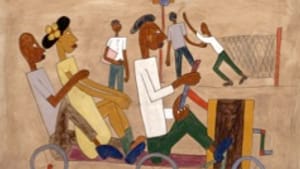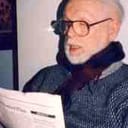Stay in the Loop
BSR publishes on a weekly schedule, with an email newsletter every Wednesday and Thursday morning. There’s no paywall, and subscribing is always free.
William H. Johnson at Art Museum (2nd review)

Colored lives (in the best sense of the word)
PATRICK D. HAZARD
For the past week I’ve been haunted by an Art Museum ad in all the papers of a color print of three black women, touting “William H. Johnson’s World on Paper.” William H. Johnson?? The first thing I did when I started teaching at Beaver College in 1962 was to start courses in Afro-American lit and African lit, to eventually complete a rubric of "International English literature," which I described in the Canadian Journal of Commonwealth Literature as "Commonwealth Lit plus US." As an interdisciplinary Ph.D., I was working up the correlative art and music for these new fields.
I had two mentors, Bill Ferris of Ole Miss and Judy Peiser of the Center for Southern Popular Culture in Memphis. Never have two young (then) done so much to retrieve forgotten or underrated portions of our American culture. Their promoting began in Jackson, Mississippi, where they worked together on the state’s sole public TV station.
Eventually, Bill, a Southern Mississippi boy, got his Ph.D. in folklore at the Penn with a dissertation on Delta blues. (His thesis was that Delta blacks felt the sting of slavery most harshly because they lost so much.) It’s still worth reading in a paperback edition. He and Charles Wilson Reagan went on to create one of the great scholarly achievements of the 20th Century, their Encyclopedia of Southern Culture. Ferris taught at Ole Miss until Bill Clinton made him chairman of the National Endowment of the Humanities. He is on the faculty of U. of North Carolina, Chapel Hill.
Imagine: He helped turn the Ole Miss of James Meredith's purgatory into a research center to which blue singers archived their achievements.
Judy, a Memphis lawyer's daughter, had set up her Center in a bungalow up town in Memphis. (She now lords it over Beale Street, where she always wanted to be.) She sent me down to Yazoo City one weekend to meet Pecolia Warner, credibly the best quiltmaker ever produced. We went back to our flight from Nashville to Philly with seven of her quilt "tops." When Bill became NEH chairman, I gave six of those to the Ole Miss Museum in his honor. I kept the best— a geometric glory of lime and orange shapes.
How come I never heard of him?
So when William H. Johnson rang no bells, my first reaction was: Did Bill and Judy let me down? For a better explanation, read the distinguished sculptor Martin Puryear’s essay in the catalogue, Homecoming: The Art and Life of William H. Johnson ($35). This poor son of Florence, S.C. (1901-1970), started his artistic life drawing in the dirt with a stick— until an observant teacher provided him with pencils. He went north at age 17 to New York when the so-called Harlem Renaissance was awakening. He did scut work to get tuition for the National Academy of Design. His painter teacher Charles Hawthorne recognized his genius and raised money for him to tour Europe. There he met Chaim Soutine and started an expressionist period. He fell in love with a Danish weaver/ceramist and they toured Europe, North Africa, and finally the Nordic North together. In Norway he met Edward Munch, and his work showed the new influence.
When Hitler started making Denmark dicey for this wife they went back to New York, and in my opinion then the strongest Johnson emerged. Subject: wartime blacks and their patriotism under the grossest of pressures. The WPA "genres" of the block and serigraph became his forte, and a "Freedom Fighter" history of American blacks his theme. Especially delectable to my eye are the jitterbugging pieces from the Savoy Ballroom on Lennox Avenue and 148th street.
Thank God for these curators
Alas, at the height of Johnson’s powers his beloved wife died of breast cancer. He tried to soldier on, but a late period syphilis paresis brought him down. He spent his last two decades in an East Islip, N.Y., asylum. The Harmon Foundation, luckily, saved Johnson’s more than 1,000 works for our ultimate savoring. Eventually they were given to the Smithsonian, where astute curators and preservationists worked endlessly to save his often-fragile works.
So the moral of this potentially tragic story is that there are Bill Ferris and Judy Peiser types at the Smithsonian (perhaps a Brit’s great gift to America). And due to the inspiration of Gwen Everett, an M.A. in art history from Howard University, we have a gorgeous kids book, Li'l and Uncle Willie ($13.95), with authentic Johnson prints.
Back in the really bad old days, the ignorant called blacks "niggers" and the civilized called them "colored." Thanks to William H. Johnson, we now have a stunning record of those "colored" in lively colors. There are many family-oriented activities connected with this exhibition.
And bless the canny curator who has "planted" four excellent black canvases along the hall that leads from the exhibition gallery. A Beauford Delaney portrait of James Baldwin, a Jacob Lawrence, and two Horace Pippins. It’s in tiny details like those which prompted William Blake to say, "He who would do me good must do it in minute particulars." Don't miss them on your way out.
For another review by Anne R. Fabbri, click here.
PATRICK D. HAZARD
For the past week I’ve been haunted by an Art Museum ad in all the papers of a color print of three black women, touting “William H. Johnson’s World on Paper.” William H. Johnson?? The first thing I did when I started teaching at Beaver College in 1962 was to start courses in Afro-American lit and African lit, to eventually complete a rubric of "International English literature," which I described in the Canadian Journal of Commonwealth Literature as "Commonwealth Lit plus US." As an interdisciplinary Ph.D., I was working up the correlative art and music for these new fields.
I had two mentors, Bill Ferris of Ole Miss and Judy Peiser of the Center for Southern Popular Culture in Memphis. Never have two young (then) done so much to retrieve forgotten or underrated portions of our American culture. Their promoting began in Jackson, Mississippi, where they worked together on the state’s sole public TV station.
Eventually, Bill, a Southern Mississippi boy, got his Ph.D. in folklore at the Penn with a dissertation on Delta blues. (His thesis was that Delta blacks felt the sting of slavery most harshly because they lost so much.) It’s still worth reading in a paperback edition. He and Charles Wilson Reagan went on to create one of the great scholarly achievements of the 20th Century, their Encyclopedia of Southern Culture. Ferris taught at Ole Miss until Bill Clinton made him chairman of the National Endowment of the Humanities. He is on the faculty of U. of North Carolina, Chapel Hill.
Imagine: He helped turn the Ole Miss of James Meredith's purgatory into a research center to which blue singers archived their achievements.
Judy, a Memphis lawyer's daughter, had set up her Center in a bungalow up town in Memphis. (She now lords it over Beale Street, where she always wanted to be.) She sent me down to Yazoo City one weekend to meet Pecolia Warner, credibly the best quiltmaker ever produced. We went back to our flight from Nashville to Philly with seven of her quilt "tops." When Bill became NEH chairman, I gave six of those to the Ole Miss Museum in his honor. I kept the best— a geometric glory of lime and orange shapes.
How come I never heard of him?
So when William H. Johnson rang no bells, my first reaction was: Did Bill and Judy let me down? For a better explanation, read the distinguished sculptor Martin Puryear’s essay in the catalogue, Homecoming: The Art and Life of William H. Johnson ($35). This poor son of Florence, S.C. (1901-1970), started his artistic life drawing in the dirt with a stick— until an observant teacher provided him with pencils. He went north at age 17 to New York when the so-called Harlem Renaissance was awakening. He did scut work to get tuition for the National Academy of Design. His painter teacher Charles Hawthorne recognized his genius and raised money for him to tour Europe. There he met Chaim Soutine and started an expressionist period. He fell in love with a Danish weaver/ceramist and they toured Europe, North Africa, and finally the Nordic North together. In Norway he met Edward Munch, and his work showed the new influence.
When Hitler started making Denmark dicey for this wife they went back to New York, and in my opinion then the strongest Johnson emerged. Subject: wartime blacks and their patriotism under the grossest of pressures. The WPA "genres" of the block and serigraph became his forte, and a "Freedom Fighter" history of American blacks his theme. Especially delectable to my eye are the jitterbugging pieces from the Savoy Ballroom on Lennox Avenue and 148th street.
Thank God for these curators
Alas, at the height of Johnson’s powers his beloved wife died of breast cancer. He tried to soldier on, but a late period syphilis paresis brought him down. He spent his last two decades in an East Islip, N.Y., asylum. The Harmon Foundation, luckily, saved Johnson’s more than 1,000 works for our ultimate savoring. Eventually they were given to the Smithsonian, where astute curators and preservationists worked endlessly to save his often-fragile works.
So the moral of this potentially tragic story is that there are Bill Ferris and Judy Peiser types at the Smithsonian (perhaps a Brit’s great gift to America). And due to the inspiration of Gwen Everett, an M.A. in art history from Howard University, we have a gorgeous kids book, Li'l and Uncle Willie ($13.95), with authentic Johnson prints.
Back in the really bad old days, the ignorant called blacks "niggers" and the civilized called them "colored." Thanks to William H. Johnson, we now have a stunning record of those "colored" in lively colors. There are many family-oriented activities connected with this exhibition.
And bless the canny curator who has "planted" four excellent black canvases along the hall that leads from the exhibition gallery. A Beauford Delaney portrait of James Baldwin, a Jacob Lawrence, and two Horace Pippins. It’s in tiny details like those which prompted William Blake to say, "He who would do me good must do it in minute particulars." Don't miss them on your way out.
For another review by Anne R. Fabbri, click here.
Sign up for our newsletter
All of the week's new articles, all in one place. Sign up for the free weekly BSR newsletters, and don't miss a conversation.

 Patrick D. Hazard
Patrick D. Hazard